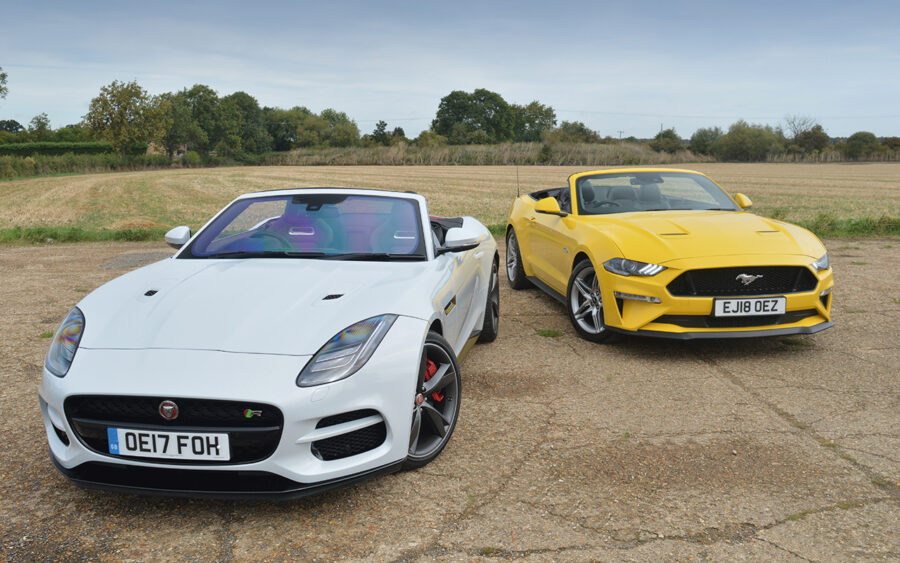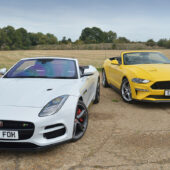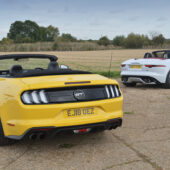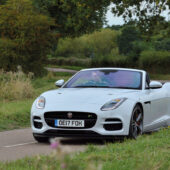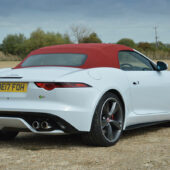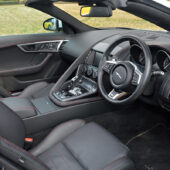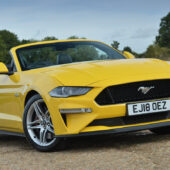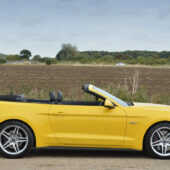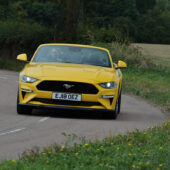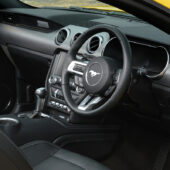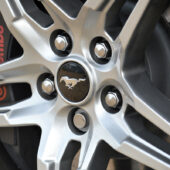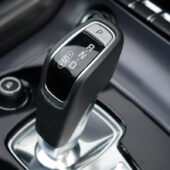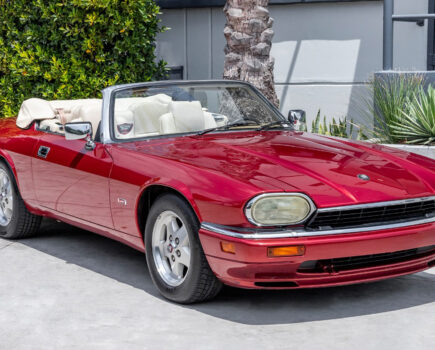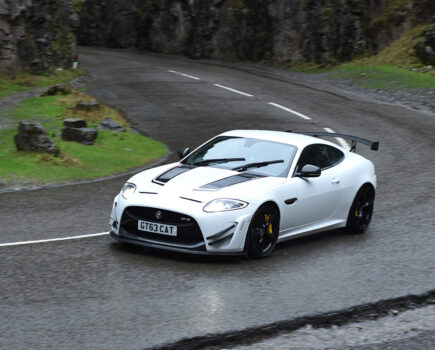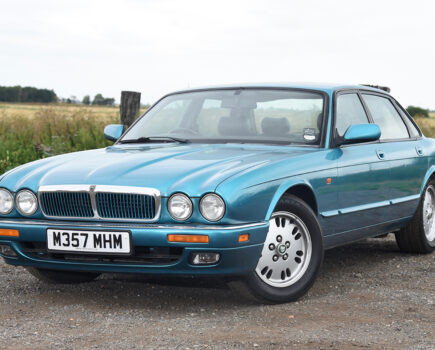With 5.0-litre V8 power and enviable heritage, the Jaguar F-Type R and Ford Mustang seem similar on paper – but is that true on the road?
Words and images: Paul Walton
Common sense would dictate that a car that costs less than half the price of another when new will only be half as good. That’s certainly what I expected when I first drove the Ford Mustang 5.0 convertible. At around £50k, its new list price really is a little under half that of the F-Type R AWD. And, sure, it’s not as good as the Jaguar, lacking the British car’s refinement and build quality, but is it only half as good? Well, no.
Despite its faults – of which there are plenty – the Mustang is still a great car. Fast, good looking and enjoyable, it makes choosing between the two as difficult as deciding between a delicately prepared pan-fried Dover sole with satisfying fish and chips. Even as I write this opening paragraph, I’m still not sure which car I think should come out on top. All I know is, it won’t necessarily be the most expensive.
They might be produced on opposite sides of the Atlantic – the F-Type in the Castle Bromwich factory, the Mustang at Ford’s Flat Rock Assembly Plant, in Michigan, USA – but the two cars have a lot in common: both have powerful 5.0-litre V8s under their bonnet and both are immensely fast; both are a return to form for the two companies and both have a long heritage.
The E-type arrived in 1961, three years before the original Mustang. While both are fast and handsome sports cars that came to define the Sixties, the Jaguar was derived from Fifties racing cars and the Ford from the humble Falcon saloon. Sadly, the pair later became larger and more bloated around the same time, the Mustang receiving some extra girth following a facelift in 1969 and the E-type convertible some extra length and the heavier V12 three years later.
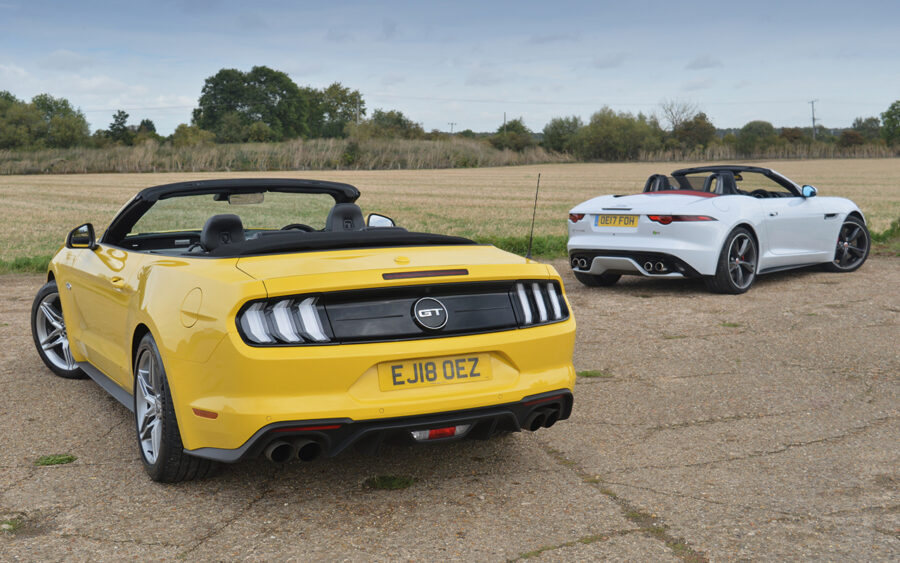
Although the American car continued when the E-type finished production in 1974, it might as well have come to an end, so poor were the following generations. Bland, slow and lacking the sharpness of the original, the subsequent three models slowly eroded the Mustang’s appeal. It wasn’t until 2005 and the fifth interpretation that the model returned to form with a good-looking car that was a clear nod towards the original thanks to the trend at the time for retrofuturism – a design movement that looked to the past for inspiration. This was followed by the current model in 2015.
Its sharp, simple lines, the swept-back C-pillars of the coupe and its large grille with galloping-horse outline in the middle pay a clear tribute to the original as much as the F-Type to the E-type, with its covered lights, circular rear-light outline and soft lines. Although neither are carbon copies, both being models in their own right, there’s little doubt about their heritage.
There is another connection more personal than similar engines and histories. While we all know the F-Type was designed by a team led by Jaguar’s current design director, Ian Callum, not so well known is that his younger brother, Moray, was until 2021, Ford’s vice president of design and no doubt had a hand in the Mustang. I wonder if they discussed their designs during Christmas parlour games? It would certainly make playing Top Trumps interesting.
Sorry, Moray, but your brother’s F-Type is the better looking of the two, having more compact proportions than its American rival, but then, the Mustang is a four-seater and, therefore, 307in longer. That’s not to say the Ford is ugly. Far from it. It’s a very eye-catching car, particularly in bright yellow (a £750 option), but, in an echo of the cars’ Sixties forebears, the Mustang’s design is less voluptuous than the F-Type R’s.
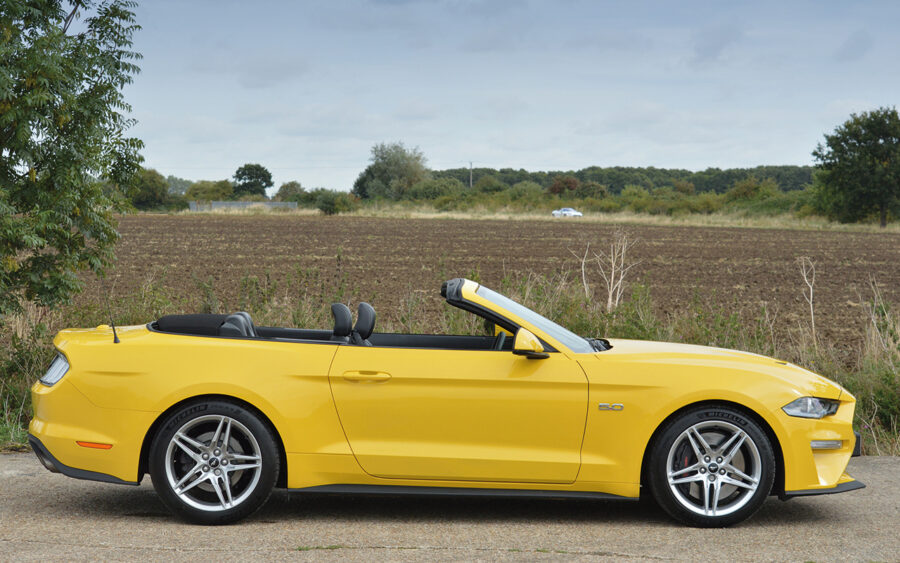
In comparison to the Jaguar’s many curves, especially at the rear, the Ford has more straight lines than an abstract painting by the Dutch artist Piet Mondrian. Also, other than the handsome vertical LED rear lights (a clear link to the 1964 original’s), the yellow car’s details aren’t as clever: the Jaguar’s door handles pop in and out while the Mustang’s appear to have been sourced from a 2001 Ford Mondeo.
Although it doesn’t look it, the Mustang is narrower than the F-Type R by 7cm, yet it still manages to offer more interior room. It is less cramped in the front, with more space between the front passengers, while the seats themselves are larger, more comfortable and offer increased support. Even the two rear seats are large enough for passengers not to lose feeling in their lower extremities. The Mustang’s boot is larger, too. At 332 litres, it offers 125 litres more storage than the F-Type, making the Mustang more practical and, perhaps, more of a rival for the XK. But, alas, that car has been out of production since 2014.
What I don’t like about the Mustang, though, is the poor quality of its interior. It lacks the finesse of the good-looking cabin in the F-Type R, and uses plastics so cheap they bring me out in sores. The materials in the Jaguar are thick with a matt finish and are generally pleasant to touch; the Mustang’s are thin and shiny, as if Ford were using up a load of Eighties plastic it had recently discovered in a warehouse, and its leather feels more like the sort of vinyl you’d find in a Seventies muscle car.
However, I do like the row of silver flicker-style switches along the bottom of the central console, but the tiny ventilation controls located just above aren’t easy to use, or to read, when driving – unlike the Jaguar’s trio of large circular dials. The Mustang’s gimmicky digital binnacle, which changes depending on the performance setting, also compares badly to the F-Type’s traditional and simpler cowled speedo and rev counter. At least the steering wheel is on the correct side of the car, since this is the first generation of Mustang to be officially sold in right-hand drive.
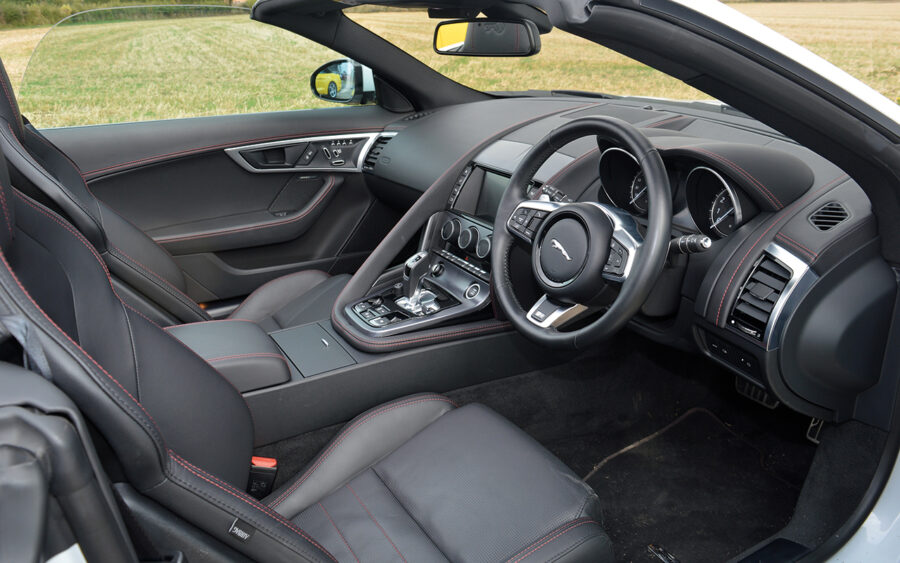
It would be easy to pass some things off as understandable, given the car’s bargain price, but another disappointment for this modern convertible is the roof mechanism. I have to manually release the Ford’s canvas roof by twisting a large latch before the electric motors take over. The Jaguar’s roof automatically detaches from the roof header, but you really would expect nothing less for the price.
Already familiar with the F-Type R, I test the Mustang first, its huge 5.0-litre V8 roaring into life the moment I press the red starter button. It has a deeper, more villainous exhaust note than Jaguar’s V8, especially under acceleration when it sounds like a proper, old-school muscle car. It’s so loud, cats give me evil stares and old ladies run
for cover.
On the road
While the power from Jaguar’s supercharged V8 constantly fizzes away just below the surface, despite having 450PS (442bhp), the Mustang’s 5038cc V8 is lazier and needs to be worked harder to get the best from it. It’s an issue not helped by the optional automatic ten-speed gearbox (yes, ten) fitted to this example that’s slower to react than a sleepy sloth.
With a clear road ahead, I stamp hard on the throttle and, as the dim-witted ’box finally changes down, the resultant acceleration is brutal. The engine isn’t as smooth or as refined as the Jaguar’s, but it is gutsy and immensely powerful, the ’box only changing up when the revs have reached a valve-bending 6500rpm. With enough torque (340lb ft) to pull that sloth out of its bed, it will accelerate irrespective of which gear the transmission is in, too. At 5.3 seconds, its 0-60mph time may be a tad over a second slower than the F-Type R’s due to the car’s bulk, but the engine’s power feels more dramatic, more exciting, a sensation emphasised by the nose rising up like a speed boat’s bow every time I accelerate hard. And that, although fun to watch, is a clear outcome of the car’s soft, wallowy ride.

Although this example is fitted with Ford’s optional MagneRide Damping System, which features a unique fluid inside the damper that can be electronically stimulated to offer higher or lower damping resistance, the car suffers considerable body roll through corners as a consequence, unlike the rock-solid F-Type. Even Sport mode, which further tightens the suspension, doesn’t calm it. Add slow steering, scuttle shake (due to a lack of rigidity and its steel body weighing 1818kg) and it’s not as easy to drive at the limit as the Jaguar; an hour behind the wheel leaves me exhausted. Driving the Mustang is like wrestling a bear – you can never relax, even for a moment.
Not that the F-Type R is all that relaxing to drive, either. With 550PS (542bhp), yet weighing a featherweight 1745kg due to its aluminium construction, it’s monstrously fast, even more so than the Ford. A slight squeeze of the throttle results in the supercharged V8 waking up with fast efficiency and viciously propelling me forward. Although more refined than the Ford V8, it’s just as loud, only in a different way.
At full chat, there is more of a high-pitched wail compared to the Mustang’s animalistic snarl (I prefer the latter, since it sounds blue-blooded, more like a real muscle car). The Jaguar sounds a bit false – too theatrical – as if it were created in a studio. Plus, the way it’s been engineered to pop and crackle under deceleration is as embarrassing as wearing a baseball cap backwards at my age.
There’s no manual gearbox option here, but the eight-speed ’box (the six-speed only comes with the V6s), isn’t as easily confused as the Mustang’s ten-speeder, being more intuitive and faster to change. This is especially so when I use the steering wheel-mounted shift paddles, although changing down lacks the Ford’s exciting rev of the engine.
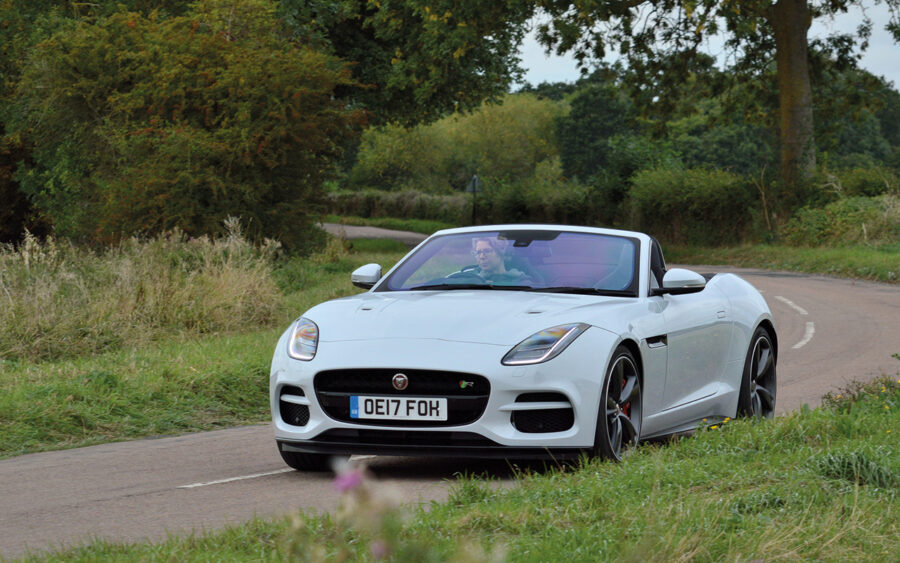
Jaguar only offers the F-Type R with all-wheel-drive now and although it feels numb compared to the old rear-wheel-drive version, it’s still sharper and less likely than the Mustang to break away into an initially exciting, but ultimately expensive, slide. Its firmly damped suspension results in little body roll, allowing the car to remain composed even through a series of fast left-right-left bends. Jaguar’s precise and nicely weighted electric steering (fitted as standard), along with the responsiveness of the V8, means I can hold the revs as I sweep my way through corners before burying the throttle at the exit and blasting down a following straight. It’s easier to drive fast than the Mustang, easier to get into a rhythm and consequently more enjoyable.
On the downside, the ride is terrible – banging over the smallest pothole in the road. In the reverse of a Dynamic mode to further tighten suspension, the F-Type needs a GT setting (as in the Aston Martin DB11) to iron out road imperfections and make longer journeys a bit more comfortable.
Jaguar F-type R vs Ford Mustang: our verdict
The Jaguar F-Type is still obviously the better car in every sense: better built, better to look at, and better to drive. Yet I can’t ignore the Mustang. It’s a fast car, a very likeable car, and has a bigger – if coarser – character than the Jaguar. It’s like comparing a Saville Row suit with a chequered shirt and dungarees. Plus, the Ford has the added advantage of two extra seats and a larger boot.
That’s just made me realise which car I’d choose, one that’s as fast and as good looking as the F-Type, but as practical and as cheap as the Mustang: a 2014 Jaguar XKR 5.0.

